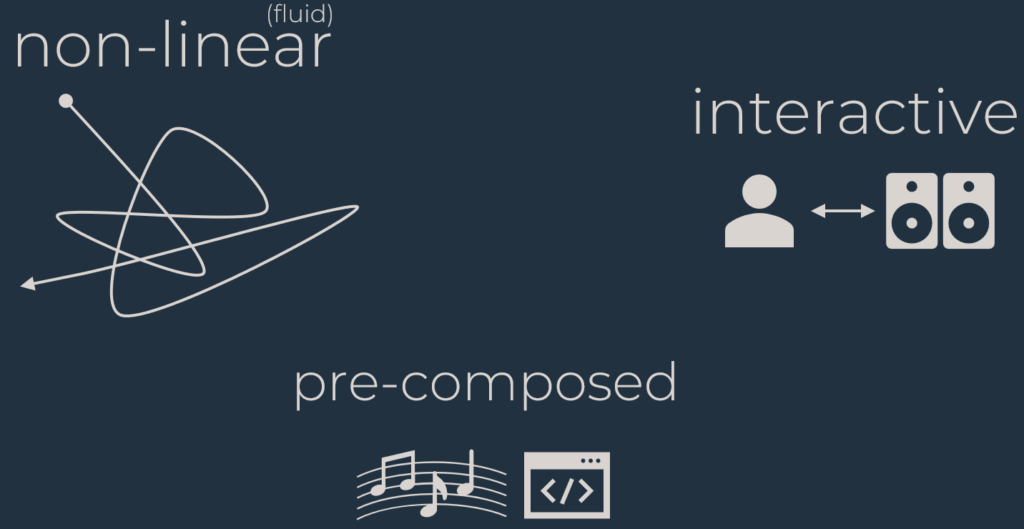Walking Soundscape
The project originally started with the idea of an interactive soundscape that one listens to on their mobile device with headphones while walking. Depending on the walking speed, motions or even geographical or meteorological data, the soundscape would change. After some further drafting and research and this idea lost its appeal for a lack of innovation – since similar applications were found.
The Emotional Space
Sticking to the core idea of a motion-reactive soundscape, I developed a concept for an installation. I wanted to create an experience of a room that audibly and visually reacts to and parallelly influences the motions of its visitors. The concept included the usage of wristbands with gyro sensors and accelerometers, just like the final version of the project. However, it was laid out as a holistic project that strived to create a unique, multimodal experience by designing and curating most of the lighting, the furniture, the architecture, the introduction and debriefing of visitors, the choice of audio technology and of course the sound design.
Inspired by some valuable feedback, the artistic vision (and therefore also the goal) of this concept became more and more fuzzy to me and I struggled to follow the red line within the project. It seemed to lack a message and a clear intention. In an approach to find new motivation, I started to dissect what I had worked out so far and tried to strengthen the project’s aspects that were intriguing to me.
The Fluid Space
The process of revisioning the concept brought me to a new title. While that may not seem like the most urgent part of the project, it did give me new inspiration. I wanted to stick to creating a ‘space’, even if that space does not lie in the physical realm. Furthermore, I had issues with the word ‘emotional’ because it created an expectation about the installation touching the visitors emotionally. Additionally, it seemed to speculate for the room to have emotions, which was not what I intended it to mean. This led me to the ‘fluid’ which captured the dynamic reactiveness that I wanted to convey a little better in my opinion.
Besides changing the title, I also moved the project away from the idea of a holistic installation and tried to direct the focus more on the interaction variants (as in movements) and how they control the soundscape. The goal for the ‘experiment phase’ of this project was a working proof of concept, using one sensor wristband.
Fluid Spaces
Finally, in the last project phase, the whole concept completely sprung into shape. I already used the term ‘explorative composition’ in the project phase before, but only in this phase called ‘product’ did I declare this term as this project’s core. I entirely focused on composing an explorative piece, which I would describe as an iterative process of producing music, coding interaction possibilities and testing, but not necessarily in that order. The process reminded me of certain aspects of game sound design, which also led me to a definition of what features a composition needs to have for me to call it explorative:
- Nonlinearity (the composition is not experienced in a linear manner, and will therefore sound different in every experience)
- Interactivity (the composition directly reacts to the listener [in this case to their movements] and triggers changes in the soundscape)
- Pre-Composition (a certain structure and intent of the composer should be derivable, narrowing down the specifications for purely generative works)
The point nonlinearity is also mentioned by Karen Collins in her book about game sound (Collins, 2008, p. 4), when describing the most important element of interactivity in games. Having all this in mind, it became clearer to me that I am rather aiming to develop a format than a single experience. While the outcome and thereby the ‘product’ of this project phase was a composition (including a performance to be able to show the composition), I was intrigued by creating explorative compositions as a format and kept this in mind during the coding process. This suggests the embedment of the format into an installation in future, as well as the creation of more compositions. Following this thought, this composition ultimately acts as a proof of concept for the format ‘explorative compositions’.

Collins, K. (2008). Game sound: an introduction to the history, theory, and practice of video game music and sound design. Mit Press.